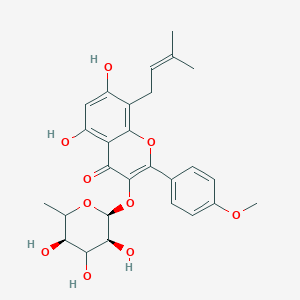
|
Baohuoside 1 |
Baohuoside 1 is a lipid of Polyketides (PK) class. |
130 |

|
Wedelolactone |
Wedelolactone is a lipid of Polyketides (PK) class. Wedelolactone is associated with abnormalities such as CLEFT LIP, CONGENITAL HEALED and Hepatitis. The involved functions are known as Signal Transduction, Cell Cycle Arrest, Apoptosis, luciferase activity and Metabolic Inhibition. Wedelolactone often locates in Protoplasm and Smooth muscle (tissue). The associated genes with Wedelolactone are CFB gene, Candidate Disease Gene, JAK2 gene, STAT2 gene and STAT3 gene. |
140 |
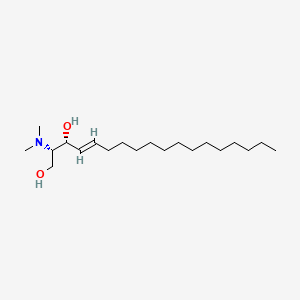
|
N,N-dimethylsphingosine |
N,N-dimethylsphingosine is a lipid of Sphingolipids (SP) class. N,n-dimethylsphingosine is associated with abnormalities such as Exanthema and Increased drug resistance. The involved functions are known as Vmax, Metabolic Inhibition, Anabolism, Binding (Molecular Function) and Cytokinesis. N,n-dimethylsphingosine often locates in yolk, Membrane, CNS - Brain (MMHCC), soluble and Tissue membrane. The associated genes with N,N-dimethylsphingosine are FPR1 gene, ANP32A gene, HPGDS gene, Nuclear phosphoprotein and PTGS2 gene. The related lipids are Sphingolipids, Phosphatidic Acid, Lysophosphatidylcholines, stearylamine and dihydroceramide. The related experimental models are Mouse Model and Knock-out. |
151 |
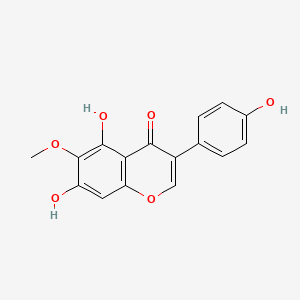
|
Tectorigenin |
Tectorigenin is a lipid of Polyketides (PK) class. Tectorigenin is associated with abnormalities such as Estrogenic effect. The involved functions are known as Phosphorylation, Metabolic Inhibition, Signal, AKT Signaling Pathway and Signal Transduction. Tectorigenin often locates in Skeletal system, Solitary microtubule component of centriole or axonemal complex, Blood and Entire gastrointestinal tract. The associated genes with Tectorigenin are IKBKE gene, BCL2 gene, CFLAR gene, XIAP gene and BCL2L1 gene. The related lipids are 21-hydroxy-9beta,10alpha-pregna-5,7-diene-3-ol-20-one. |
161 |
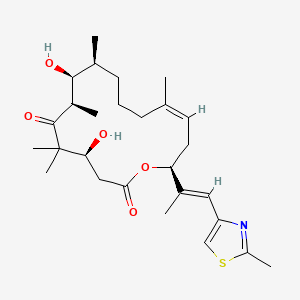
|
Epothilone D |
Epothilone d is a lipid of Polyketides (PK) class. Epothilone d is associated with abnormalities such as Tauopathies, Neutropenia, Neuropathy and Hematological Disease. The involved functions are known as Mutation, Apoptosis, Mitotic arrest, Cell Growth and Anabolism. Epothilone d often locates in Cytoskeleton, Axon, Cell Wall, Chromosomes and Spindle. The associated genes with epothilone D are SLC33A1 gene, Chromatin, GTF2I gene and HEXA gene. |
174 |
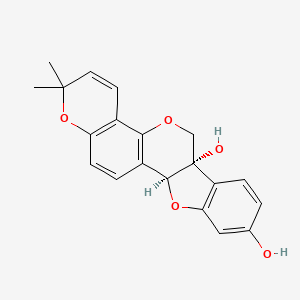
|
Glyceollin |
Glyceollin is a lipid of Polyketides (PK) class. Glyceollin is associated with abnormalities such as Malignant Carcinoid Syndrome, Infection, infection induced, Diabetes and Diabetes Mellitus, Non-Insulin-Dependent. The involved functions are known as Agent, Binding, Competitive, Signal Transduction, Gene Expression and Transcription, Genetic. Glyceollin often locates in Body tissue, Epithelium, viral nucleocapsid location, Membrane and Mouse Uterus. The associated genes with Glyceollin are CXCL12 wt Allele, PGR gene, Genes, Reporter, TFF1 gene and NGFR gene. The related experimental models are Xenograft Model. |
177 |

|
butein |
Butein is a lipid of Polyketides (PK) class. Butein is associated with abnormalities such as Glomerulonephritis, Fibrosis, Liver, Kidney Failure, Acute, Mastocytosis and Chimera disorder. The involved functions are known as Phosphorylation, Transcription, Genetic, IkappaB kinase activity, Gene Expression and Signal Transduction. Butein often locates in Membrane, Cytoplasmic, IkappaB kinase complex, Protoplasm and Plasma membrane. The associated genes with Butein are ICAM1 gene, MAPK8 gene, MYC gene, BCL2 gene and BCL2L1 gene. The related lipids are Promega. The related experimental models are Xenograft Model, Knock-out and Mouse Model. |
190 |
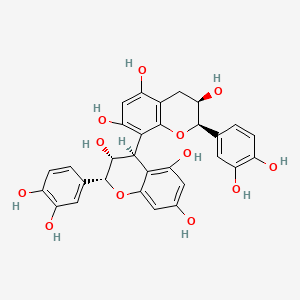
|
Procyanidin B2 |
Procyanidin B2 is a lipid of Polyketides (PK) class. The involved functions are known as conjugation, Methylation, Excretory function, enzyme activity and sulfatase activity. Procyanidin b2 often locates in Blood, Epidermis and Upper Gastrointestinal Tract. The associated genes with Procyanidin B2 are NR5A2 gene, HRAS wt Allele, CFB gene, PTGS2 gene and MAPK8 gene. |
205 |
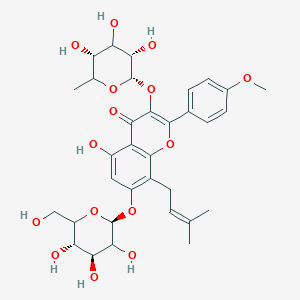
|
LMPK12112009 |
LMPK12112009 is a lipid of Polyketides (PK) class. |
216 |
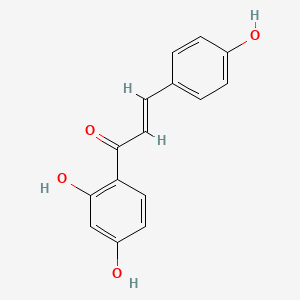
|
isoliquiritigenin |
Isoliquiritigenin is a lipid of Polyketides (PK) class. Isoliquiritigenin is associated with abnormalities such as abnormal fragmented structure, Gastric ulcer, Gastric mucosa lesion, Peptic Ulcer and Wiskott-Aldrich Syndrome. The involved functions are known as Mass-to-Charge Ratio, Anabolism, Oxidation, inhibitors and Energy Absorption. Isoliquiritigenin often locates in Microsomes, Liver, Hepatic, Microsomes, Immune system and Vacuole. The associated genes with Isoliquiritigenin are P4HTM gene, BCL2 gene, AP1AR gene, oxytocin, 1-desamino-(O-Et-Tyr)(2)- and ODAM gene. The related experimental models are Knock-out. |
220 |
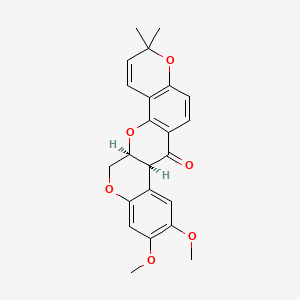
|
Deguelin |
Deguelin is a lipid of Polyketides (PK) class. Deguelin is associated with abnormalities such as Hypertensive disease, Parkinson Disease and athymia. The involved functions are known as inhibitors, Drug Interactions, ATP binding, Down-Regulation and Angiogenesis. Deguelin often locates in Endothelium, Vascular and Body tissue. The associated genes with Deguelin are MAP2K1 gene. |
246 |
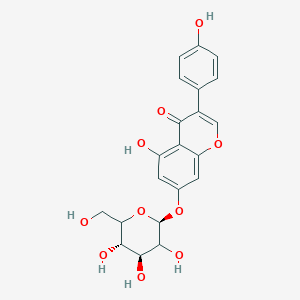
|
genistein 7-O-glucoside |
genistein 7-O-glucoside is a lipid of Polyketides (PK) class. Genistein 7-o-glucoside is associated with abnormalities such as athymia, Heart Diseases, Thyroid Diseases, Plague and Brucella infections. The involved functions are known as Cell Proliferation, Binding (Molecular Function), Ingestion, topoisomerase activity and kinase activity. Genistein 7-o-glucoside often locates in Membrane, Gastrointestinal tract structure, Oral region, Body tissue and Blood. The associated genes with genistein 7-O-glucoside are GLUCOSIDASE, PPP1R1A gene, Homologous Gene, Genome and FUSE gene. The related lipids are Sterols, 1,2-oleoylphosphatidylcholine, Membrane Lipids and DOPE. |
264 |
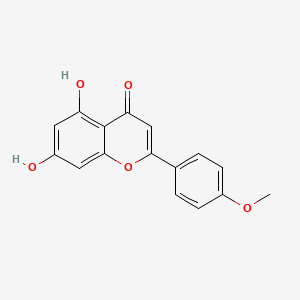
|
acacetin |
acacetin is a lipid of Polyketides (PK) class. Acacetin is associated with abnormalities such as Cardiovascular Diseases, Janiceps and Meralgia paresthetica. The involved functions are known as Cell Cycle Arrest, Cell Growth, Agent, Metabolic Inhibition and Cell Death. Acacetin often locates in Protoplasm, Membrane, Plasma membrane, Capillary blood and Endothelium. The associated genes with acacetin are CDKN1B gene, KCNH2 gene, MSMP gene, COX8A gene and PI3 gene. The related lipids are Lipopolysaccharides. The related experimental models are Xenograft Model. |
277 |

|
(-)-Perillyl alcohol |
(-)-perillyl alcohol is a lipid of Prenol Lipids (PR) class. The involved functions are known as Cell Cycle Progression, Cell Cycle, Cell Proliferation, Apoptosis and Isoprenylation. (-)-perillyl alcohol often locates in Cytoplasm, Membrane and Plasma membrane. The associated genes with (-)-Perillyl alcohol are JUN gene, Candidate Disease Gene, IL24 gene, BCL2L1 gene and CFB gene. The related experimental models are Transgenic Model. |
299 |
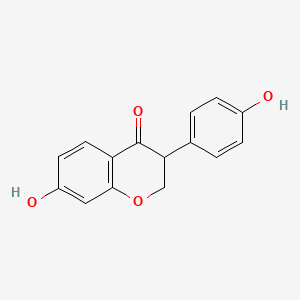
|
dihydrodaidzein |
dihydrodaidzein is a lipid of Polyketides (PK) class. Dihydrodaidzein is associated with abnormalities such as Bacteremia, Little's Disease and Postmenopausal syndrome. The involved functions are known as Metabolic Process, Cellular, racemization, Cytokinesis, enzyme mechanism and Stereochemistry. Dihydrodaidzein often locates in Cell-Free System, Face, Blood, Back and Cytoplasm. The associated genes with dihydrodaidzein are HOXA10 gene and tryptones. The related lipids are enterodiol. |
338 |
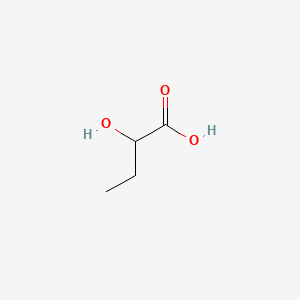
|
(+/-)alpha-hydoxy butyric acid |
(+/-)alpha-hydoxy butyric acid is a lipid of Fatty Acyls (FA) class. |
390 |
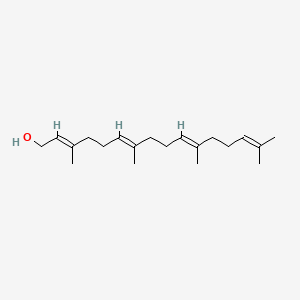
|
Geranylgeraniol |
Geranylgeraniol is a lipid of Prenol Lipids (PR) class. Geranylgeraniol is associated with abnormalities such as abnormal fragmented structure, Hyperostosis, Diffuse Idiopathic Skeletal and Tuberculosis. The involved functions are known as Positive Regulation of Apoptosis, Anabolism, Prenylation, Apoptosis and pathologic cytolysis. Geranylgeraniol often locates in Body tissue, Cytoplasmic matrix, Red Cell Ghost, Spindle and Nuclear lamin. The associated genes with Geranylgeraniol are MST1 gene, STN gene, UMOD gene, ABCA1 gene and RHOA gene. The related lipids are Sterols, Hydroxycholesterols, SK&F 104976 and 25-hydroxycholesterol. |
403 |
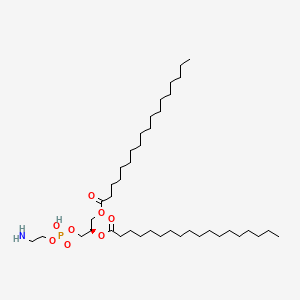
|
1,2-Distearoyl-sn-glycero-3-phosphoethanolamine |
1,2-Distearoyl-sn-glycero-3-phosphoethanolamine is a lipid of Glycerophospholipids (GP) class. 1,2-distearoyl-sn-glycero-3-phosphoethanolamine is associated with abnormalities such as Painful Bladder Syndrome, Dehydration, Renal tubular disorder, Gigantism and Tumor-Associated Vasculature. The involved functions are known as conjugation, Ligand Binding, Process, Laser-generated electromagnetic radiation and Blood Circulation. 1,2-distearoyl-sn-glycero-3-phosphoethanolamine often locates in Tissue membrane, Early endosome, Body tissue, Cell surface and Membrane. The associated genes with 1,2-Distearoyl-sn-glycero-3-phosphoethanolamine are R peptide, P4HTM gene, NHS gene, TSPO gene and SLC33A1 gene. The related lipids are Liposomes, 1,2-distearoylphosphatidylethanolamine, Micelles, Fatty Acids and sialogangliosides. |
438 |
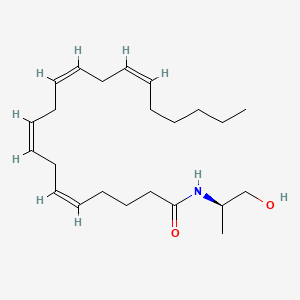
|
N-(1R-methyl-2-hydroxy-ethyl) arachidonoyl amine |
N-(1r-methyl-2-hydroxy-ethyl) arachidonoyl amine is a lipid of Fatty Acyls (FA) class. |
457 |
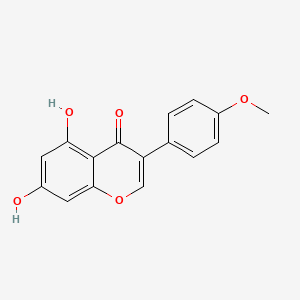
|
biochanin A |
Biochanin a is a lipid of Polyketides (PK) class. Biochanin a is associated with abnormalities such as Osteoporosis. The involved functions are known as Uptake, adenosinetriphosphatase activity, inhibitors, Drug Interactions and Metabolic Inhibition. Biochanin a often locates in Membrane, Tissue membrane, Microsomes, Microsomes, Liver and Entire oral cavity. The associated genes with Biochanin A are CD9 gene, SLCO1B1 gene, ABCG2 gene, EDNRB gene and SPAG8 gene. The related lipids are Steroids, Androstenols, Sphingolipids and 1,2-oleoylphosphatidylcholine. |
465 |



















